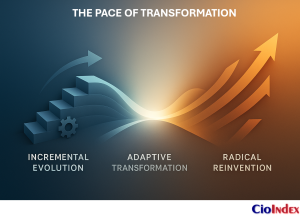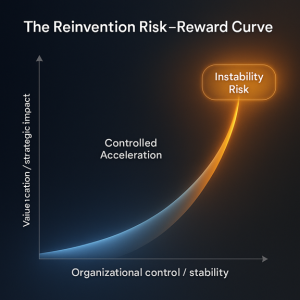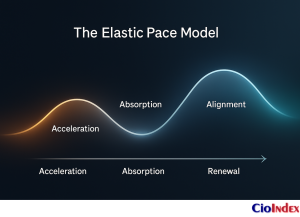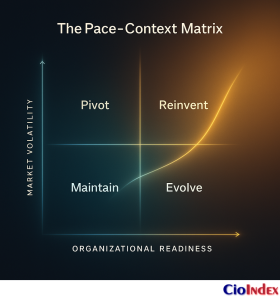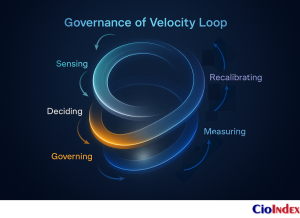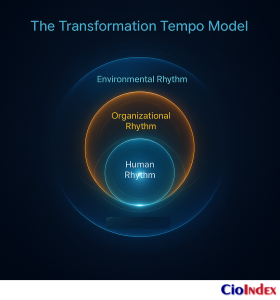The Debate Over Pace: The Question of Speed
Digital transformation has redrawn the boundaries of competition, but the pace of change now determines who endures and who erodes. Speed has become a strategic variable — powerful enough to redefine advantage, volatile enough to destabilize it. It measures how swiftly intent becomes capability, how effectively organizations convert possibility into performance. No longer a byproduct of progress, velocity has become a condition for survival.
Transformation once advanced through controlled modernization — structured programs designed to deliver progress without disruption. Planning cycles stretched across years, and governance prized certainty over speed. As markets compressed and technologies converged, control gave way to urgency. Crises such as the pandemic, supply-chain breakdowns, and the sudden ascent of artificial intelligence exposed how brittle static systems had become. Acceleration turned from ambition into reflex, forcing organizations to move faster than their structures could sustain.
This is where the great divide emerges. On one side stand the advocates of incremental evolution — the belief that steady, deliberate progress builds durable systems and cultures. On the other side are the champions of radical reinvention — the conviction that only bold, decisive shifts can break through legacy constraints and reset competitive position. Both are right, and both are wrong. Incrementalism protects stability but risks irrelevance. Radicalism ignites progress but can fracture institutions not built for such velocity.
The paradox is that transformation succeeds or fails not because of technology, but because of timing. The organizations that thrive learn to synchronize their rate of change with their structural and cultural readiness — accelerating when momentum compounds value and decelerating when absorption lags behind ambition.
A third logic is emerging — one that treats transformation as a living rhythm rather than a fixed tempo. This adaptive transformation expands and contracts in response to readiness, risk, and opportunity. It is neither perpetual caution nor unrestrained acceleration, but the conscious governance of motion.
The question is not how fast to move, but how deliberately to shape velocity — accelerating when capability compounds value, slowing when cohesion must catch up. Speed without rhythm destabilizes; rhythm without speed stagnates. The balance between the two defines digital maturity.
Incremental Transformation — Evolution at the Edges
Transformation often begins at the edges, not the core. The instinct is to test change where the risk is lowest — a new process here, a digital channel there, a modernized system that leaves the rest intact. These early steps form the pattern of incremental transformation: modular upgrades, gradual optimization, and deliberate preservation of continuity. It is change measured in manageable degrees — improvement without rupture.
Its logic lies in control. Incremental transformation enables organizations to modernize without dismantling what already works. It suits environments where governance is mature, capital is disciplined, and stability is valued as much as speed. Risk is distributed across smaller, reversible bets. Each initiative provides evidence of progress while preserving operational confidence — transformation as stewardship rather than upheaval.
The advantages are tangible. Incrementalism reinforces stability, ensures governance coherence, and encourages compounding learning — where each cycle of improvement builds new capability on top of the last. Processes become leaner, decision-making more informed, and systems more connected. Over time, this iterative motion strengthens operational resilience: the organization learns to adapt without losing balance. Progress is steady, cumulative, and largely predictable.
The appeal of this approach runs deeper than structure — it is psychological. Incremental change feels safer because it allows progress without pain. It reassures leadership that modernization can coexist with continuity. Employees experience learning without threat, and executives can demonstrate forward motion without destabilizing existing performance metrics. It is transformation that sustains morale as much as margin.
But its strengths conceal familiar risks. Inertia often hides beneath discipline; incrementalism as avoidance replaces deliberate design with delay. Governance, intended to ensure control, can become a mechanism for resistance. The enterprise optimizes its past instead of constructing its future. Gradual change becomes a comfort zone — an illusion of progress that buys time but erodes relevance. By the time the need for reinvention becomes undeniable, capacity for bold change has quietly atrophied.
The difference lies in intent. Used deliberately, incremental transformation is a staging model — a way to build confidence, capability, and proof before scaling ambition. Used defensively, it becomes an avoidance mechanism disguised as prudence. The distinction determines whether incrementalism serves transformation or suffocates it.
Metrics reveal the difference. Healthy incremental programs demonstrate measurable gains in process efficiency, innovation absorption, and operational resilience. They show shorter feedback loops, higher change adoption rates, and an upward trajectory in digital competency. Unhealthy ones produce activity without acceleration — more projects, more dashboards, but no structural lift in capability or performance.
When Incrementalism Works
Low-volatility industries | Heavily regulated environments | Process-driven cultures | Stable governance ecosystems
Procter & Gamble demonstrates how incremental transformation can sustain advantage without rupture. Its modernization has been governed through precision — embedding analytics into decision-making, automating workflows, and scaling digital tools division by division. Each capability was tested, absorbed, and then extended. The sequence preserved performance while compounding learning, ensuring that progress became structural rather than symbolic. The company evolved continuously, not through disruption but through disciplined renewal — an organization learning how to modernize without losing itself.
Incremental transformation is therefore not a lesser form of change but a discipline of precision — transformation calibrated to context. It teaches the enterprise how to change without breaking, how to learn before leaping. But it also requires the wisdom to recognize when continuity becomes constraint — when evolution must yield to reinvention.
Radical Transformation — Reinvention at the Core
Where incremental transformation refines, radical transformation redefines. It begins not at the edges but at the center — questioning the assumptions, structures, and cultures that once sustained advantage. It is transformation as re-architecture: replatforming technology, reshaping identity, and reinventing the business model itself. The aim is not improvement but renewal — to replace what no longer scales with what can sustain the future.
Radical transformation is often provoked by existential shifts — market collapse, technological disruption, or investor pressure that exposes the limits of continuity. When relevance erodes faster than reform, leadership confronts a simple truth: optimization cannot bridge the gap. The organization must be rebuilt for a different competitive logic. That realization drives a decisive break — replacing architectures, realigning governance, and redesigning culture to operate with new purpose and velocity. Transformation becomes a founding act, not a maintenance program.
The appeal is immediate. Radical reinvention can leapfrog legacy, freeing enterprises from the structural drag of accumulated complexity. It creates strategic clarity — a unified narrative of why change must happen now and how value will be redefined. The burst of momentum re-energizes the workforce and signals conviction to markets and investors. When coherence is maintained, radical transformation resets both position and perception: the enterprise is no longer adapting to the system — it is rebuilding it.
The same energy that fuels renewal can very easily turn destructive. Cultural shock, execution fatigue, and governance collapse are frequent by-products of acceleration without absorption. Decision rights blur, leadership bandwidth fractures, and exhaustion replaces engagement. The initial surge of alignment can dissolve into noise as teams chase simultaneous priorities without shared cadence. Radical transformation succeeds only when its velocity is matched by the organization’s ability to metabolize change.
At the governance level, reinvention also reconfigures authority. Hierarchy gives way to venture logic: decisions migrate closer to value creation, and accountability becomes fluid. This agility enables speed but strains coherence. The center must evolve from command to coordination — guiding through principles rather than prescriptions. Leadership shifts from control to orchestration, setting tempo rather than issuing directives.
Patterns of reinvention reveal a consistent contrast. ING’s agile transformation succeeded because acceleration was governed through design — radical structural change paired with cultural grounding and governance continuity. GE Digital’s overreach, by contrast, illustrates the opposite: ambition that expanded faster than cohesion. Vision outpaced absorption, and complexity outran control. The pattern recurs across industries. Where reinvention is driven faster than the enterprise can digest, over-centralization, leadership turnover, and mission drift follow. The issue is rarely vision; it is velocity.
The Risk–Reward Equation of Reinvention
Radical transformation rewrites value but can also erase stability. The same acceleration that propels renewal can dislocate identity if coherence, governance, and culture do not evolve at the same speed.
Radical transformation is therefore both promise and peril — a deliberate wager that disruption can be mastered from within. It is the high-risk, high-yield end of the transformation spectrum: a choice to trade certainty for potential. Its outcome depends less on the boldness of vision than on the discipline of design — knowing what to break, what to preserve, and when to pause long enough for meaning to catch up with motion.
Reinvention is not the opposite of evolution; it is its culmination when change deferred becomes change compressed. The challenge is not to choose between the two, but to know when incremental progress must yield to structural redesign — and when radical ambition must slow long enough to become sustainable.
The Missing Middle — Adaptive Transformation as Rhythmic Strategy
Between the caution of incrementalism and the volatility of reinvention lies a third mode — one defined by rhythm rather than ideology. Adaptive transformation balances bursts of acceleration with deliberate consolidation. It is the choreography of speed and stability: a leadership discipline that expands and contracts in tune with readiness, risk, and learning. Change advances in waves — momentum followed by absorption, alignment followed by renewal.
Its defining capability is strategic elasticity — the ability to flex pace without fracturing coherence. Adaptive organizations know when to move fast to capture opportunity and when to slow down to sustain cohesion. This elasticity is not compromise but control: a capacity to maintain structural integrity while navigating shifting velocity. The goal is not maximum speed, but right speed — motion matched to meaning.
Adaptive transformation operates as a sequence of controlled waves — acceleration, absorption, alignment, renewal. Each phase informs the next through feedback and sensing. Leaders set tempo by attention, not decree, ensuring that the organization’s rhythm mirrors its readiness. Progress becomes cyclical, not continuous — designed to sustain rather than exhaust.
Culturally, this rhythm restores energy renewal and sustained focus. Teams remain engaged because progress feels purposeful, not perpetual. Momentum is replenished by reflection; learning is built into motion. Adaptive transformation prevents fatigue by making consolidation as valued as acceleration — teaching organizations that endurance depends on pause as much as push.
Microsoft exemplifies this rhythmic strategy. Under Satya Nadella, the enterprise alternated between sprints of cloud innovation and periods of cultural grounding. New capabilities were tested at high speed but scaled only after cohesion was regained. The shift from a “know-it-all” to a “learn-it-all” culture reflected this elasticity: leadership set tempo through sensing and trust rather than command. The outcome was not just renewal of business models, but renewal of energy.
“Adaptive transformation isn’t a compromise — it’s the choreography of speed and stability.”
Adaptive transformation resolves the false polarity between evolution and reinvention. It proves that maturity lies not in moving fastest, but in moving wisely — advancing through rhythm, not reaction. Transformation endures when speed becomes conscious and stability becomes dynamic.
The Spectrum of Pace — Matching Speed to Context
No two organizations transform at the same speed. Pace is not a universal metric but a contextual equation — determined by the volatility of markets, the maturity of systems, and the elasticity of culture. The right speed for one organization may be reckless for another. Transformation succeeds not by racing ahead, but by matching velocity to environment and readiness.
The pace an enterprise can sustain emerges from a balance of forces — some external, others internal — that define both its urgency and its capacity to change. Among the most influential are industry volatility, which dictates urgency; regulatory pressure, which constrains freedom; digital maturity, which defines capability; capital structure, which sets investment tempo; and cultural elasticity, which determines how much change people can absorb before coherence fractures. Together, these forces form the landscape within which every transformation must find its rhythm.
This balance can be understood through the Pace–Context Matrix — a model that relates transformation intensity to both organizational readiness and environmental volatility.
| Quadrant | Context | Transformation Mode | Governance Response |
|---|---|---|---|
| Maintain (Low–Low) | Stable market, low capability | Optimize efficiency | Tight control, predictable cadence |
| Evolve (High–Low) | Stable market, high capability | Incremental evolution | Delegated authority, measured investment |
| Pivot (Low–High) | Turbulent market, low capability | Accelerate selectively | Centralized coordination, risk buffering |
| Reinvent (High–High) | Turbulent market, high capability | Radical transformation | Distributed governance, high-frequency feedback |
The matrix reveals that pace is relational. It depends not only on ambition but on where the enterprise stands within this grid. Governance calibrates accordingly: in stable environments, it enforces consistency; in volatile conditions, it channels experimentation. Maturity determines whether control enables progress or suppresses it.
Certain signals mark when to accelerate — market inflections, competitive pressure, innovation plateaus, or technological openings. Others signal when to decelerate — organizational fatigue, decision latency, or cultural misalignment. Reading these signals requires situational awareness: the ability to sense when momentum serves meaning and when it begins to erode it.
External triggers amplify these dynamics. Regulation can slow transformation by design; technology disruption can render delay catastrophic. Shifting societal expectations — from sustainability to data ethics — can demand new forms of pacing altogether. Timing becomes the true variable of transformation: success depends not on constant motion, but on recognizing the window where change compounds advantage.
The consequences of misjudging pace are costly. Moving faster than capability creates chaos — governance overload, cultural burnout, and operational risk. Moving slower than opportunity breeds irrelevance — lost markets, disengaged talent, and strategic decay. The art lies in synchronizing momentum with maturity, ensuring that speed remains a function of readiness, not rhetoric.
Pace Profiles by Industry Type
| Industry | Typical Pace | Key Constraint | Enabler |
|---|---|---|---|
| Banking | Incremental | Regulation | Compliance-by-design systems |
| Manufacturing | Adaptive | Legacy systems | Industrial IoT |
| Technology | Radical | Talent fatigue | Continuous deployment |
| Healthcare | Incremental | Ethics & policy | Data interoperability |
| Retail | Adaptive | Margin pressure | Omnichannel agility |
Transformation pace is contextual — the question is not how fast to move, but how accurately to match motion with moment. The art lies in synchronizing momentum with maturity, ensuring that speed remains a function of readiness, not rhetoric.
The Governance of Speed — Regulating Motion Across the Enterprise
Once the right pace is known, it must be governed. Matching speed to context is only the beginning; sustaining that rhythm requires design. Governance translates judgment into discipline — converting awareness of pace into structures, feedback loops, and decision rights that keep transformation in tune.
Speed without structure becomes volatility; structure without speed hardens into inertia. Between them lies governance — the mechanism that regulates motion without suppressing it. Governance of speed is not about restraint but rhythm: the orchestration of decision flow, accountability, and information to ensure that acceleration produces coherence, not chaos.
Every enterprise that masters transformation eventually builds an architecture of pace. It is through governance that rhythm becomes reproducible — where tempo is encoded in strategic reviews, investment cycles, and feedback cadence. Velocity, to be sustainable, must be architected.
Effective governance operates across three layers. At the strategic level, leadership defines the horizon and investment tempo — how fast capital, capability, and culture are expected to evolve. At the tactical level, priorities are sequenced, decision rights clarified, and resource flow aligned to momentum. At the operational level, data feedback and performance cadence ensure that motion is monitored in real time. Each layer synchronizes around one principle: pace must match capacity.
Leadership acts as the metronome of transformation — setting rhythm through clarity and context rather than control. Tempo is reinforced through communication, not coercion: when to accelerate, when to stabilize, when to pause for integration. In adaptive enterprises, rhythm is governed by awareness, not authority.
Information is the true regulator of speed. Transparent systems, sensing networks, and cross-functional feedback loops allow leadership to perceive friction early and act with precision. Governance becomes perceptual rather than procedural — an architecture of listening more than enforcing. This responsiveness transforms bureaucracy into an adaptive nervous system.
The best systems of control are those that flex. Adaptive governance introduces thresholds that expand and contract with readiness — scenario triggers that recalibrate intensity when conditions shift. Flexibility converts governance from constraint into capability, allowing organizations to absorb uncertainty without losing coherence.
Amazon demonstrates this dual-speed logic in practice. Its innovation engines — AWS, Alexa, and Prime — operate at high velocity, empowered by decentralized decision rights and iterative loops. Yet every experiment remains tethered to a disciplined backbone: standardized operating principles, common review rhythms, and leadership mechanisms that align innovation with enterprise coherence. Speed is distributed, but control is never absent.
“Governance is not friction; it is the instrument that keeps speed in tune.”
Governance of speed converts transformation from motion into mastery. It ensures that acceleration serves intent, that decisions create direction, and that rhythm endures under pressure. In a landscape defined by perpetual change, governance is not what slows transformation — it is what makes transformation sustainable.
The Hidden Variable — Organizational Metabolism
Two organizations can adopt the same strategy, deploy identical technologies, and invest equally in change — yet one accelerates while the other stalls. The difference lies in what cannot be easily seen or benchmarked: organizational metabolism — the internal rate at which an enterprise can absorb, align, and adapt to transformation.
Metabolism converts energy into movement — in biology, food into vitality; in organizations, strategy into execution. It determines how quickly ideas become action, how well disruption is digested, and how sustainably performance can grow. A strategy that overwhelms an organization’s metabolic rate produces fatigue, not progress.
Organizational metabolism is composed of four interdependent dimensions:
- Decision throughput — how rapidly choices move from insight to action.
- Cognitive load — how much change the enterprise can process before clarity collapses.
- Process agility — the flexibility of structures to redirect resources and workflows in real time.
- Emotional bandwidth — the psychological and cultural capacity to sustain confidence during continuous change.
When these elements are balanced, transformation feels fluid. When misaligned, the system overheats. A common leadership signal of metabolic stress is when project cycles compress faster than capability cycles — when execution accelerates beyond the organization’s ability to learn, absorb, or realign. The result is fatigue disguised as momentum.
The Transformation Metabolism Model expresses this dynamic as a continuous rhythm: Absorb → Align → Accelerate → Adapt.
Each phase builds on the last: absorption stabilizes learning, alignment synchronizes intent, acceleration channels energy into results, and adaptation resets equilibrium for the next wave. Skipping any phase breaks the loop — progress outpaces understanding, and performance becomes unsustainable.
| Phase | Purpose | Leadership Focus |
|---|---|---|
| Absorb | Integrate new knowledge, systems, or change signals | Reflection, learning, clarity |
| Align | Synchronize people, processes, and priorities | Communication, coherence, trust |
| Accelerate | Execute with focused intensity | Empowerment, simplification, decision speed |
| Adapt | Internalize outcomes and recalibrate systems | Review, feedback, renewal |
Metrics reveal the health of this metabolism:
- Change absorption rate — how quickly new initiatives are stabilized.
- Initiative recovery time — how long it takes to regain performance equilibrium after change.
- Leadership adaptation index — how effectively decision-makers recalibrate priorities under evolving conditions.
- Learning velocity — how fast skills evolve relative to technological change.
Architecture plays a defining role. Composable systems, automation, and API readiness increase metabolic efficiency by reducing friction between functions. The less energy required to connect, the faster the organization can transform without overheating.
Spotify exemplifies high-metabolism design. Its “alignment autonomy” model allows small, empowered squads to move independently while staying connected through shared purpose and transparent governance. Decisions travel quickly because intent is clear and coordination is lightweight. Energy is distributed without dilution — the hallmark of a system built to metabolize change continuously.
“Transformation succeeds at the rate an organization can absorb it — not at the rate it is imposed.”
Organizational metabolism explains why identical strategies diverge in outcome. It turns transformation from a race into a rhythm — a measure not of ambition, but of assimilation. The enterprise that understands its metabolic rate learns to change at the speed of its own intelligence.
The Leadership Equation — Governing the Velocity
Metabolism defines potential; governance converts it into control. An organization may process change quickly, but without deliberate regulation, energy becomes turbulence. The next determinant of transformation is therefore not capability alone, but how leadership governs the pace it has created.
The task of leadership is to turn rhythm into regulation — to translate the enterprise’s internal rate of absorption into an external system of decisions, priorities, and permissions that keeps motion coherent. Pace becomes a leadership equation, balanced through governance: how ambition is weighted against capacity, how risk is calibrated against readiness, and how momentum is sustained without exhaustion.
Transformation moves at the tempo leaders design. The true regulator of speed is not technology or process, but governance — the collective discipline by which leaders align aspiration with absorption. When direction is clear, risk understood, and rhythm shared, pace becomes intentional. When these conditions break down, velocity turns random — accelerating where coherence is weakest and stalling where confidence is highest.
Governing transformation velocity requires control through design, not decree. Pace emerges from leadership systems that distribute attention, authority, and adaptation in measured cycles. Four levers determine whether the organization’s motion remains sustainable:
- Portfolio balance — the ratio between core and edge initiatives. Overweighting the experimental creates volatility; ignoring it breeds stagnation.
- Decision cadence — the frequency with which priorities are reviewed and realigned. Too infrequent, and relevance fades; too constant, and strategy dissolves into churn.
- Risk thresholds — the boundaries within which experimentation can occur safely. Clear parameters encourage initiative without chaos.
- Funding logic — resource allocation that evolves dynamically, following performance and potential rather than static planning cycles.
These levers form the architecture of motion — the governance by which ambition is translated into manageable tempo.
The greatest constraint in most transformations is not resistance, but decision latency — the lag between sensing a signal and acting upon it. Latency reveals how quickly authority moves through the system, how aligned leaders are around purpose, and how effectively governance converts information into movement. Reducing latency is not about haste; it is about frictionless coherence.
High-velocity enterprises use feedback loops and sensing mechanisms to detect both overload and underdrive. Dashboards, retrospectives, and pulse surveys reveal whether momentum is building or burnout is emerging. These signals feed directly into leadership review rhythms, where pacing decisions — acceleration, stabilization, or recalibration — are made consciously, not reactively.
Governance at this level must be adaptive, not ceremonial. Static oversight structures collapse under the speed of digital transformation. Instead, modern enterprises employ rolling-wave planning and agile governance — mechanisms that operate continuously, adjusting in short cycles as new data arrives. Such frameworks prevent the drift between strategy and execution, keeping leadership alignment and enterprise tempo synchronized. It is governance in motion: fast enough to respond, structured enough to maintain integrity.
At its most strategic, governance becomes a shared equation between the CIO and the board. The CIO senses momentum from within; the board perceives risk from above. Alignment between these two lenses determines the enterprise’s velocity vision — how much risk it can responsibly absorb, and how rapidly it can advance without losing control. When that dialogue is mature, governance becomes anticipatory rather than corrective.
Metrics reveal the health of this equilibrium:
- Decision latency — time from signal to decision.
- Change success rate — proportion of initiatives that achieve intended outcomes without rework.
- Cultural recovery cycle — time it takes for morale and focus to stabilize after major change waves.
Together, these form the vital signs of organizational velocity — indicators of whether speed is serving strategy or consuming it.
“In transformation, governance sets the tempo — leadership sets the tone.”
When leadership treats speed as a governance variable, transformation gains intelligence. Motion becomes measured, feedback becomes continuous, and progress becomes sustainable. The outcome is not faster change for its own sake, but change that can keep pace with purpose.
The Cost of Acceleration — When Speed Becomes Instability
Acceleration is seductive. It signals progress, commands attention, and feeds the narrative of transformation as conquest. Beyond a certain threshold, momentum ceases to compound advantage and begins to consume it. What appears as progress can quickly become instability — a loss of coherence, context, and collective rhythm.
Every system has a point at which energy exceeds absorption. In enterprises, that limit is reached when change velocity outpaces learning velocity, when governance reacts faster than understanding can form, and when communication can no longer synchronize direction. The result is motion without meaning — a surge of activity that erodes the very confidence it sought to build.
Acceleration carries hidden costs across four dimensions:
- Cognitive overload — decision fatigue, fragmented attention, and short-termism.
- Structural stress — process bypassing, governance shortcuts, and collapse of standardization.
- Cultural erosion — trust declines as pace becomes pressure; collaboration gives way to compliance.
- Strategic myopia — leaders measure motion rather than impact, mistaking urgency for significance.
When speed exceeds the organization’s metabolic rate, these forces combine into transformational turbulence — rapid oscillation between overextension and retrenchment. Projects multiply; priorities blur; initiatives compete for oxygen. The system begins to cannibalize its own capacity to focus.
At this stage, acceleration feeds on itself. What began as transformation becomes compensation — running faster to stay still.
Leadership symptoms are unmistakable: meetings increase while clarity decreases; governance accelerates but insight lags behind. The enterprise feels simultaneously busy and stalled — the paradox of hyperactivity without advancement.
The antidote is not deceleration but recalibration. Sustainable transformation depends on restoring equilibrium between energy and absorption. This requires three disciplines:
- Temporal awareness — recognizing that progress has seasons; even the fastest cycles need consolidation.
- Contextual sensing — continuously reading cultural and operational bandwidth before amplifying speed.
- Rhythmic intervention — deliberately inserting pauses for recovery, reflection, and reorientation.
At the governance level, this means slowing to learn, not to stop — introducing short reflective intervals after acceleration phases to capture lessons, redistribute load, and realign leadership focus. These micro-pauses prevent fatigue from becoming failure.
The financial and strategic costs of ignoring these thresholds are steep: rising turnover, declining innovation quality, degraded trust in leadership, and the silent accrual of organizational debt — the cultural counterpart to technical debt. Once accumulated, it slows every subsequent initiative, eroding the very velocity that caused it.
Ultimately, the measure of transformation maturity is not how fast an organization can move, but how consciously it can modulate motion. The most advanced enterprises know that endurance, not acceleration, defines advantage. They treat speed as a renewable resource — to be spent wisely, replenished deliberately, and governed with restraint.
“Beyond a certain threshold, speed stops creating progress and starts consuming it.”
The Human Dimension — Talent, Learning, and Psychological Sustainability
Every transformation eventually encounters its human limit. Technology can accelerate indefinitely, but people cannot. The capacity of an enterprise to evolve is bounded not by strategy or systems, but by the rate at which its people can learn, adapt, and recover. This is the hidden frontier of velocity — the intersection between pace and psychology.
At its core, learning velocity determines transformation velocity. Organizations cannot outpace the speed at which their workforce acquires new skills, integrates new meanings, and reconstructs shared confidence. When change advances faster than understanding, performance becomes mechanical; culture turns brittle. The signal is not resistance but exhaustion — people complying without conviction.
Reskilling and sense-making form the absorptive capacity of transformation. Reskilling equips; sense-making aligns. Both depend on psychological safety — the trust that allows individuals to admit uncertainty, to learn publicly, and to recover from failure without fear. Without that safety, acceleration fragments teams, and the social metabolism that converts knowledge into action breaks down.
The ethical dimension of pace lies here. Ethical pacing recognizes that endurance has moral weight. Leaders who drive unrelenting speed without recovery inflict what can be called acceleration fatigue — the chronic depletion of attention, empathy, and creativity. It erodes not only productivity but meaning, turning transformation into survival.
Sustainability in transformation is therefore not only financial or environmental; it is psychological. Governing for speed includes governing for recovery. Every rhythm requires rest — intervals where learning consolidates and confidence renews. These pauses are not inefficiencies but investments: periods of stability that enable the next surge of growth to begin from trust rather than fatigue.
Leadership defines the emotional cadence of change. Tone, empathy, and clarity set the pace as much as strategy or technology. Leaders who model composure and curiosity create emotional gravity — a stabilizing force that prevents acceleration from fracturing culture. In such systems, empathy functions as a pacing mechanism: it regulates ambition through awareness of impact.
The most adaptive enterprises now approach learning velocity as a governance concern, not a training function. They measure absorptive capacity with the same discipline applied to performance indicators — tracking skill evolution, engagement depth, and recovery cycles. By embedding learning and wellbeing into governance, they convert compassion into continuity.
“Transformation endures when learning moves as fast as technology — and recovery as fast as change.”
The human dimension completes the equation of pace. It reminds leadership that no system can accelerate sustainably if its people cannot breathe. Transformation may begin with technology and governance, but it endures only through the rhythm of learning, trust, and renewal.
The Equilibrium of Transformation — Finding the Sustainable Tempo
Every transformation must eventually find its rhythm — a balance between urgency and understanding, ambition and absorption. The most successful organizations are not those that move the fastest, but those that govern their motion with precision. They know that progress is not a race but a rhythm — a sustained tempo that converts energy into endurance.
Equilibrium does not mean stillness. It means continuity without collapse: the ability to accelerate and recover, to push and pause, to evolve without disintegrating. In practice, this equilibrium emerges when strategy, structure, technology, and culture move in phase — when the system’s metabolism, governance, and learning capacity operate as one coherent cycle.
Sustainable transformation is not a single speed but a dynamic cadence — fast enough to stay ahead, deliberate enough to stay intact. It is achieved through synchronization, not through force. The organization becomes less like a machine and more like an organism: sensing, adapting, and self-correcting in real time.
Leaders create this equilibrium by treating pace as a strategic resource, not a reflex. They regulate speed the way they manage capital — investing it where momentum multiplies value, conserving it where volatility threatens coherence. Over time, this produces a form of operational resilience that is both disciplined and dynamic — a system that endures because it breathes.
Transformation maturity, therefore, is measured not by the scale of change achieved, but by the stability of rhythm sustained. The mature enterprise has learned to accelerate consciously, decelerate purposefully, and pause intentionally. It transforms not as reaction, but as renewal — guided by awareness rather than anxiety.
“The future belongs to organizations that can move fast — and recover faster.”
Transformation ultimately becomes a matter of tempo — the art of harmonizing pace with purpose. When that harmony is achieved, speed becomes sustainable, change becomes continuous, and progress becomes permanent.
Finding the Tempo of Transformation
Digital transformation is not a contest of speed but a discipline of rhythm. The difference between momentum and chaos lies in how leaders pace it — when they choose to accelerate, when they choose to stabilize, and when they allow systems to breathe.
Incremental change preserves coherence. Radical reinvention creates possibility.
But neither, on its own, sustains progress. The real advantage belongs to those who learn to regulate tempo — to sense when energy must compound and when culture must absorb.
Every transformation unfolds across three rhythms:
the environmental pulse of disruption and opportunity,
the organizational cadence of governance and decision,
and the human tempo of learning, focus, and renewal.
Governance sets the tempo. Leadership sets the tone.
And together, they turn transformation from a race into a rhythm — one that adapts, renews, and endures.
The enterprises that thrive will not be the ones moving fastest, but those moving most consciously — synchronizing their rhythm with the world around them, and with the people who carry its pace forward.
